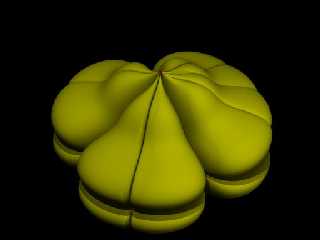|
 |
I did some experiments to express the SuperFunction from
Dave Vogt's post with a single isosurface. It seems to work
fine.
Dave's original links:
[1] http://www.heise.de/newsticker/meldung/45863
[2] http://www.genicap.com/
[3] http://astronomy.swin.edu.au/~pbourke/povray/supershape/
The PovRay code as a Macro:
......................................
#macro Super_Function_3D (m1, a1, b1, n11, n21, n31, m2, a2, b2, n12, n22, n32 )
isosurface {
function {
pow( pow(abs(cos(0.25*m2*asin(z/sqrt(x*x+y*y+z*z)))/a2),n22) +
pow(abs(sin(0.25*m2*asin(z/sqrt(x*x+y*y+z*z)))/b2),n32)
,1/n12) *
pow( pow(abs(cos(0.25*m1*acos(y/sqrt(x*x+y*y))*abs(y)/y)/a1),n21) +
pow(abs(sin(0.25*m1*acos(y/sqrt(x*x+y*y))*abs(y)/y)/b1),n31)
,1/n11) *
sqrt (x*x+y*y+z*z)
- 1
}
max_gradient 20
contained_by { box { <-2,-2,-2>,<2,2,2> } }
}
#end
.........................................
And a test image with the following parameters taken from an example on link [3]:
{ Super_Function_3D ( 7, 1, 1, 20.45, -0.33, -3.54, 6, 1, 1 ,-0.96, 4.46, 0.52 ) }
Regards, Hans
Post a reply to this message
Attachments:
Download 'superfunction_isosurface.jpg' (14 KB)
Preview of image 'superfunction_isosurface.jpg'

|
 |




![]()